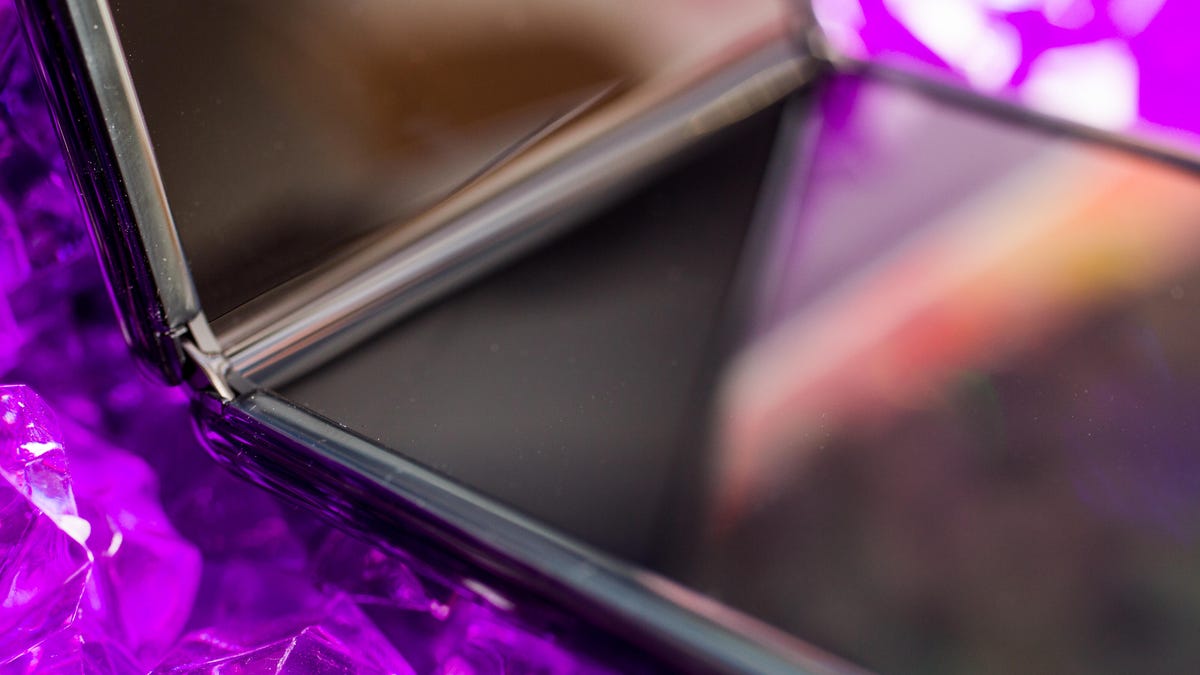Samsung confirms Z Flip's display really uses glass that's only 30 microns thin
The statement comes after questions about its screen. A German company supplies the glass, but Samsung processes it to make the display.

Samsung's new Galaxy Z Flip has something new and somewhat controversial: a foldable glass screen. In the short time the foldable has been available, its display has been applauded for offering something found in no other devices on the market. But it has also been criticized for not being as durable as regular glass.
Questions have arisen about which company made the glass -- and if it's even glass at all.
It turns out Samsung's own display business has "commercialized" the ultra-thin glass, or UTG, for the "cover window" of the Galaxy Z Flip. But it doesn't actually make the glass layer itself. A German company, called Schott, said it manufactures the glass and sends it to Samsung to be embedded with the other layers of the display.
Samsung Display on Wednesday told CNET that it produces the display for the Galaxy Z Flip. "Schott only supplies unprocessed raw materials to us," a spokesman said.
Late Tuesday, Samsung Display said the glass, which is 30 microns (0.03mm) thick, "is produced using an intensifying process to enhance its flexibility and durability." The company injects the UTG with a "special material up to an undisclosed depth to achieve a consistent hardness."
It didn't provide more details about the "special material" or the process but said it has labeled the glass "tough, yet tender." Samsung noted it "features a highly flexible surface with a supple hardness, sleek texture and uniform shape."
On Wednesday, Schott said it provides the glass to Samsung to be used in the Z Flip.
"Schott has been producing ultra-thin glass for more than 25 years -- based on this strong heritage, we are extremely happy to help shaping the future of foldable phones with this breathtaking material," The company said. "We can confirm that we deliver Schott ultra-thin glass to Samsung." But it said it can't comment on any processing details of the raw glass material or the display technology itself.
Samsung is best known for its TVs and smartphones , but it also has huge operations building components like processors and displays. The South Korean electronics giant not only uses the technologies in its own devices but also sells them to customers. The new innovations tend to show up in Samsung products first, much like the ultra-thin display for the Galaxy Z Flip.
Samsung introduced the Galaxy Z Flip last week and started selling it Friday for $1,380. Most companies don't even have one foldable phone, but Samsung now has two. And they're very different from each other. The Flip is more like a smartphone that becomes more pocketable when closed, while last year's Galaxy Fold is a phone that opens up to reveal a bigger tablet. The hope for Samsung is that the Flip avoids the many problems faced by its predecessors, including high pricing and lack of apps.
Fragile foldables?
The use of glass in the Flip is a first for the foldables market and is something that could give the sector a boost. Glass doesn't scratch as easily as plastic, is generally more durable and also will give the Flip a more premium feel than other foldables available for sale.
But the Flip's glass screen already has seen some controversy. Tinkerer Zack Nelson, who runs the JerryRigEverything YouTube channel, put the handset through a battery of durability tests and came away disappointed by the results. He found that even his fingernail was capable of leaving scratches on the phone's screen at a point in the test where real glass would have typically resisted markings. Nelson questioned whether the Z Flip's screen actually was glass at all (Samsung has maintained that it is).
The problems noted by Nelson raise doubts about the durability of foldables. The Galaxy Fold had screen problems when it hit the market last year, and Motorola's Razr may have issues of its own. Both companies have stood behind their devices, though they also include warnings for buyers about the fragility of the foldable screens.
Samsung Display on Tuesday said it has worked with Bureau Veritas, an international certification agency based in France, to test UTG's durability. The glass has lasted through 200,000 fold tests "simulated extreme life-time use reliability," Samsung said. That's enough for the phone to last for about five years.
Schott has developed very thin glass for foldable phones.
Samsung Display noted that it's trademarking "Samsung Ultra-thin Glass" and its existing polyimide (PI) cover window. The company said it has been working with another Korean company on commercializing UTG since 2013.
While Samsung Display's UTG has arrived first in the Z Flip, the company said "the glass is expected to be adopted by other foldable electronic devices, when demand arises."
Corning -- which makes some of the world's most durable glass for devices like Apple 's newest iPhones -- has been developing its own foldable glass. CNET got an exclusive look at the technology in late 2018. At that time, Corning's bendable glass was about 0.1mm thin and could bend almost in half like a piece of paper to a 5mm radius. It has not yet appeared in devices.
Originally published Feb. 18.
Update, Feb. 19 at 2:41 p.m. PT: Includes a comment from Schott, which says it supplies the glass that's used in Samsung's "ultra-thin glass" for the phone maker's foldable display, and 7:51 p.m. PT: Includes additional information from Samsung about the display's glass.

